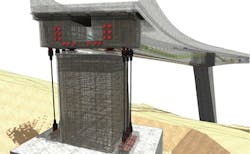A path across the gorge: the Tamina Bridge
With an arched span of 869 ft, a superstructure length of 1,369 ft and a height of 772 ft above the valley floor, the Tamina Bridge—planned by the engineering office Leonhardt, Andrä und Partner (LAP)—is the largest arched bridge in Switzerland. LAP used Allplan Engineering to create the structural design and draft and tender documents, and it helped the project come in one year ahead of schedule.
The challenge
This project had steep valley embankments, its supporting structure is an arch with a span of 869 ft, and continuous beams connect via the piers and arched supports. The arch is tensioned in the horizontal elements on both sides. The cross-section height varies between 13 ft at the horizontal element and 6.5 ft at the crest. The width varies from 29 ft at the horizontal element to 16 ft at the crest. In order to reduce the weight of the arch, it was designed as a hollow cross-section on over half of its length. A hollow concrete box forms the superstructure. The bridge width of the superstructure was planned to be 21 in., so that two bridge members can easily be arranged side by side. In order to create space for the tension anchorages, the longitudinal girders are spaced at 47 in. at the ends of the building sections.
The roadway construction is a maximum of 19 in. thick. Its thickness reduces to 12 in. between the girders. As with the girders, the slab thickness at the end of the construction sections is increased to allow for the placement of the tension anchors. Due to the plan having circular arches at the ends of the structure, it was necessary to design a variable cross-slope of the roadway, which creates torsion of the pavement structure in some areas of the bridge.
The vertical elements are connected to the horizontal elements and superstructure, designed as a rectangular, walk-on cross-section. In order to shorten the supporting width of the foreshore bridges, the piers are not arranged perpendicularly, but rather vertically to the arch. The pillars on the arch are designed to be solid and have concrete joints at the foot and head. The connection to the arch and superstructure is monolithic. The superstructure and the piers act like a frame; the pillars act as pendulum supports. Mounting on longitudinally displaceable supports occurs at the abutments. The horizontal elements and abutments are designed with flat foundations.
The solution
Allplan Engineering was used as planning software from the start. LAP was able to create detailed virtual models, including pre-tension cables, reinforcements and fixtures. These 3D models in the design phase helped LAP demonstrate the constructability of the design—especially the pre-stressed element guides and reinforcement—and helped the tendering companies better understand the complexity of the framework. Identifying potential problems early in the design phase also saved time and overrun costs.
